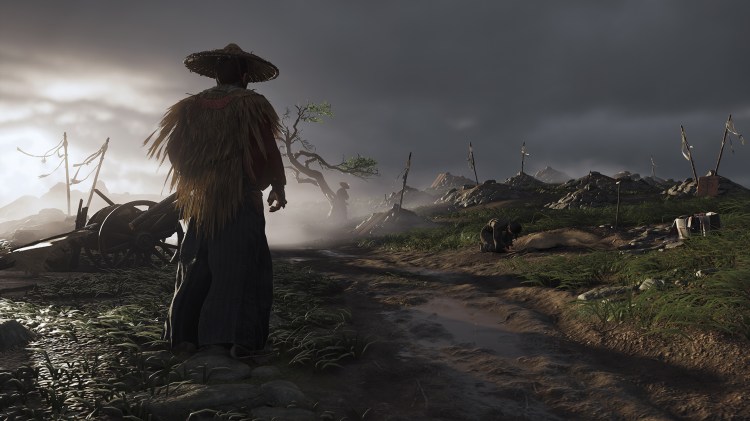Can an American game studio make one of the best samurai video games ever? That’s the question for Sucker Punch as it develops Ghost of Tsushima, an action-adventure sword fighting game set during the 13th century Mongol invasion of Japan.
The last series Bellevue, Washington-based Sucker Punch worked on was Infamous, which starred a series of badass superhero Americans with plenty of attitude. But Chris Zimmerman, cofounder of Sucker Punch, believes his studio can meet that challenge of creating a samurai game that meets even Japanese tastes for authenticity.
We talked with Zimmerman in a group interview and in a small session with Ars Technica’s Kyle Orland at the Electronic Entertainment Expo (E3), the big game trade show in Los Angeles where Sony highlighted it as one of the top exclusives coming for the PlayStation 4. As you can see in the video below, the game has incredible graphics. It depicts Jin Sakai, the last samurai on the island of Tsushima as it faces the Mongol invasion in 1274. Based on what I’ve seen, this was one of my favorite games of E3.
Zimmerman went into a lot of detail about the research Sucker Punch has done to make sure the game lives up to expectations and how it will be crafted as a game with a universal story. Here’s an edited transcript of our interview. The game’s launch date hasn’t been set yet.
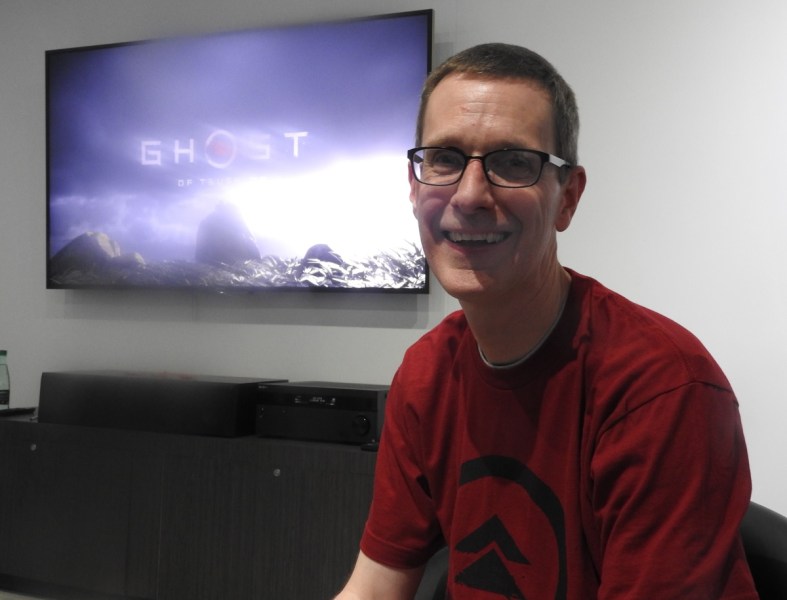
Above: Chris Zimmerman is cofounder of Sucker Punch, maker of Ghost of Tsushima.
Chris Zimmerman: We’re trying to build a time machine here, a machine that takes you back to this place in time: Tsushima during the Mongol invasion in 1274. For me, this part of the demo is a particularly good time machine. If you go to Japan, one thing that’s inescapable is just how green the place is. Wherever you look, it’s a green wall, verdant, lush. You look at this and think, “Didn’t they get carried away with all the stuff here?” No, this is what Japan looks like. When we were there, I thought, “I hope we can capture this in the game,” and I think this part of the demo does a great job of that. When we show this to our Japanese friends at Sony, they say, “I feel like I’m at home.” That’s what we’re aiming for.
When we started working on this section of the game, working on the combat for Ghosts, one of the taglines we had — which this shot really captures — is “mud, blood, and steel.” That sense of groundedness in reality, trying to transport you to that place and time and make you feel what it meant to be this character fighting back against incredible odds. It’s important for us that, as you play through something like this, you’re transported. That means every fight is different. This is not canned, not just a big set piece. This is just the game running.
That’s the approach we took to building the demo we showed at the press conference. Not just, “Let’s build something for E3,” but, “Let’s take the game and show it.” That was important for us, that we capture what the game is about. The game is about mud, blood, and steel. It’s about being in a situation where these guys who have underestimated you have just learned that they shouldn’t have done that. It’s about tracking the flight of every speck of blood to see where it hits. It’s about tracking where the Mongols have gone so they have a realistic amount of blood on their costumes.
The short synopsis of that conversation — is anyone here fluent in Japanese? No? Then you don’t know whether I’m telling you the truth or not. Jin and Masuko have met here to find the monk, but they have a disagreement about the monk. Masuko is very angry with the monk. Through some stuff he’s done, he brought about the death of her family, and she thinks he should be dealt with harshly. Jin’s response is to say, “He’s helping us fight back against the Mongols. He’s an inspirational leader. We can’t abandon him. We need him.”
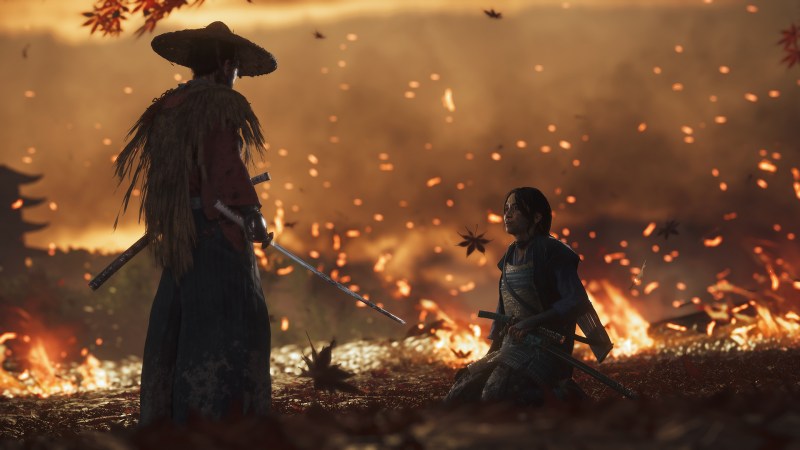
Above: Jin squares off with Masuko in Ghost of Tsushima.
Even though Masuko and Jin are on the same side, they don’t have the same ideas about how to deal with the invasion. That’s part of making a game that has nuance, that has a story you care about — realizing that not everyone is going to react the same way or take the same path to survival in these extreme circumstances. This shot just screams romance to me too, by the way. You have the stone steps, the green, all the lanterns, the temple we’re about to see.
This is an open world game. If you’re playing for real, you could easily decide that you’re just going to blast into the temple and deal with whatever you find inside. But Jin thinks, “I want to save the monk. Maybe I should check what’s going on, reconnoiter a little bit.” We noticed earlier a hole in the roof that he might be able to peer through. Here he’s going to use a grappling hook. Maybe he can go up on top to get a better look.
One thing you may be thinking is, “Wait, this is a samurai game, right?” It is. Jin is a samurai. But just being a samurai is not enough. Part of the story of the game is that Jin is discovering how everything he’s been taught, everything he’s tried to be, isn’t enough to deal with the Mongols. There are just too many of them. He’s forced to invent something beyond what he’s learned as a samurai, to use tactics like this. This is not honorable. This is not bushido. This is something else. This is him saying, “Well, if I’m going to save the monk, maybe I’ll take that guy first.”
If I move quickly I can take out all these guys before they can get to the monk. Ah, but there was a fourth guy he didn’t see. That guy blew the alarm. Now we need to move, because there are more Mongol reinforcements on the way. I need to free the monk and get out of here. You can see the specks of blood, which are actually the specks that hit him. We track the flight of those.
Jin says here, “If we fight each other, the Mongols win.” Masuko says, “They’ve already won.” She’s given up. Jin, even though he knows it’s the wrong thing to do, she’s left him with no choice. Masuko and Jin, their differences are to the point where the only thing they think they can do is have this very iconic duel. And there you have it, just a little bit of the story of Jin and Masuko.
Now, this is not the golden path. This is not the main storyline of the game. This is something off to the side. It’s emblematic of the game, but it’s not entirely about Jin’s story. It’s about the story of the people of the island and how they react. This is the intersection of Jin’s story and Masuko’s story. We didn’t want to give away the details of the golden path quite yet, so we decided to take a part that was about Jin’s relationship with Masuko and their story together. Just tell a little bit of that here without giving too much away.

Above: The skies and landscape looks so realistic in Ghost of Tsushima.
Question: Can you talk about how the game controls? The combat looks very fluid. You’re dodging and counterattacking.
Zimmerman: How to talk about this? Let me talk about goals rather than getting into the details. The goal, again, it’s a time machine. We’re trying to make you feel what it’s like to be in this situation. We drew from a whole bunch of different points of inspiration, all with the goal of having this level of intensity that we really want you to feel when you’re holding three feet of sharp steel and you’re facing three people who want to kill you. That’s what we’re trying to get.
We started from a bunch of different places. We looked at HEMA, the historical martial arts reenactment enthusiasts. We obviously owe a big debt to samurai cinema. All kinds of stuff. All trying to figure out what would capture the essence of being a samurai.
One thing that was important to us was thinking about the character of the movement. If you watch how Jin moves, there’s something samurai about it. That’s because we have domain experts, experts in historical Japanese sword fighting techniques that we brought in to work with us and develop something that brings together that historical basis with the things we need to do to make it a video game.
Part of that is about having the sense of lethal precision to what the samurai is doing. He’s moving very intentionally. He’s staying balanced. There’s a purpose to every move he makes. Having our Japanese historical sword fighting expert with us in the mocap suit, helping capture this stuff, was really instrumental to that. You can see the sense of punctuated motion. You have this very iconic rhythm of pose, move, pose. If you watch samurai cinema you associate that with being a samurai.
Question: So if the player decides to mash buttons, that probably won’t work very well.
Zimmerman: That might be a strategy that will work for a while, but it won’t work for very long. With all games you want to make sure there’s a mix. Our goal with the combat is to make sure there’s a mix of pure empowerment feelings — there are 12 guys and you just go through them — all the way up to a one-on-one meaningful fight with another person who’s really your peer. And all points in between. We have a combat system that runs that whole gamut. The things you can do in your fight with Masuko are no different from the things you would do fighting some bandits. It’s just that she’s much harder to deal with, much more capable. That brings out more of what you can do.
Question: My impression is that you guys are an American studio. Culturally I’m interested in the relationship of an American studio making a game about Japan for a Japanese publisher.
Zimmerman: First of all, it’s great being part of Sony. That means we have support from people who really care about this. This is important to many people at Sony, that we get this right. We have a lot of support both from people in Japan and native Japanese people working in the states. We’re a multicultural studio as well, so that always helps. We have a strong Asian presence at Sucker Punch, and that helps too. There’s a sense that this is important and we need to get it right.
We’ve worked hard to make sure we’re bringing in appropriate people to help. Whether that’s talking about syncretism in Japanese religious life, or getting the details of a conversation right, or making sure the swords are accurate, it’s been great to assemble the team we have. It’s not just Sucker Punch. It’s everyone working with us to make sure this game is what it can be. It’s been a lot of fun.
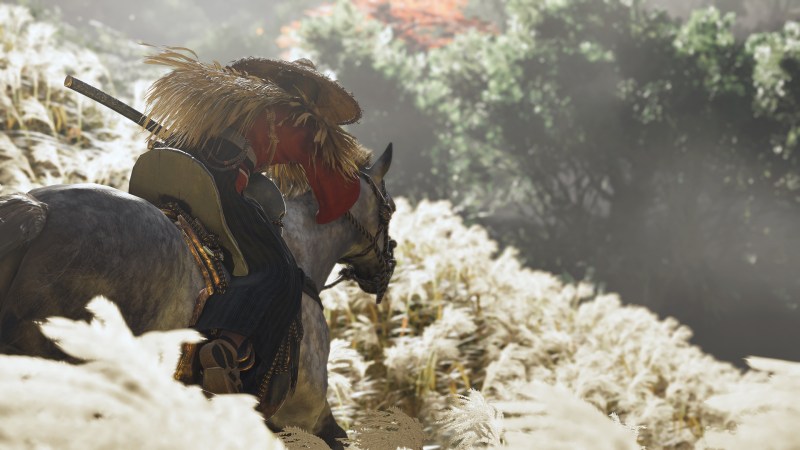
Above: The fauna sways in the wind in Ghost of Tsushima.
Question: Is there a point where you had to make a pitch and say, “Trust us with this?”
Zimmerman: We were worried about that. When we got started, we were super excited about this. I’m super excited about doing this game. I remember when we were talking about it and said, “This all lines up. The Mongol invasion, Tsushima, it’s perfect.” There’s such a rich story to tell here. We were so excited about telling that story that we were just vibrating. Will we be allowed to do this? Despite all the work we’re able to do, we’re still an American studio. Is this going to be okay with Sony as a greater corporate entity?
It was really surprising and gratifying to hear that the answer was yes, that Sony was excited about doing this. When we did the trailer we showed last fall at the Paris game show, we did it in Japanese and put it out in Japan, and it got a zillion views. People were excited about it. They don’t think we’re going to make the same game that a Japanese studio would make about this time period, and that’s okay. We’re going to tell a story that we hope is universal, that everyone can relate to, that’s our take on this time and place. We hope we can take people back there, and I think we’ve been relatively successful so far. Fingers crossed that we can pull it off all the way.
Question: You said you’re running this live. Is the game going to be completely without a HUD?
Zimmerman: We take the HUD off for things like this because it’s distracting. If I put the HUD up during this everybody just wonders, “What does that thing mean? What does this thing mean?” You don’t really need to care about that right now. It’s light, but there is some HUD. There are things we could do without a HUD, but realistically, sometimes the best answer is to be able to say, “Here’s your objective,” and put that text on the screen instead of assuming you can infer that. So, HUD-less, no. Light HUD, yes.
Question: The moments where you could stop, is that just a developer option?
Zimmerman: It’s funny. Obviously we’ve been working on this for a long time. We were trying to work through how we’re going to do these demos. How are we going to talk? We knew we were going to play it live, but fundamentally, we want to get something new across with these demos, so how can we talk about it? We thought, “If only we had some feature that would let us stop and look around,” and we realized we did: the photo mode we used for Second Son. We thought, “Okay, let’s just turn on photo mode,” and that’s what you’re seeing.
Question: When you’re showing the world and the weather system, is that weather going to be dynamic?
Zimmerman: Absolutely, that’s dynamic. These clouds are procedural. They’re not drawn. They’re simulated. Those clouds are always changing. You’ll never see that same cloudscape again.

Above: Stealth combat in Ghost of Tsushima.
Question: The demo is voice acted in Japanese. Does that Japanese voice acting have its own matching lip sync?
Zimmerman: We haven’t decided exactly what we’re going to do. The fact that it’s in Japanese now, although it represents our vision for the game, it’s sort of a development miracle that we could make that happen for E3, because this stuff doesn’t get wrapped until not that long ago, and then it has to make a round trip to get acted and re-integrated. The guys worked really hard to make sure that we could show the game we’re building – one where, if you want to play it in Japanese, you should be able to play it in Japanese.
We’ll see what the results are. It’s important to us that the Japanese version feels natural. We have some extraordinarily skilled people involved. If they’re good enough at the dubbing process, then we may be able to not have to do that. But time will tell.
Question: Do you have role-playing game systems here, more complex progression systems?
Zimmerman: We’re not talking about details, but you’re in the right ballpark. This is an open world game. I think the expectations that you have about what a great open world game is, those are our expectations as well. We’ll see. The game’s in process. We’re not done. Obviously it’s playable here, and it’s playable on a larger scale. We’re doing playtests every six weeks. This is not shallow. This is just us showing a part of something that’s pretty broad and deep.
That said, until you have it all done, some of the questions you’re asking can’t be answered. We don’t know exactly—were the game to have anything like crafting in it, you really don’t know how you’re going to be able to do something like that and how it will all fit together until you’re actually in the middle of hour 20 of a 40-hour playthrough. All numbers are estimates until you know how it feels in the large. You just don’t know. I could give you answers, but who knows what’s going to change between now and the finish?
Question: Do you see any comparison to For Honor, as another sword fighting game?
Zimmerman: It’s going to sound like a weak answer, but we really don’t compare ourselves to other games. That’s not how we think. Sometimes we’re inspired by other games, but we don’t think of ourselves that way. We don’t make decisions that way. We try to identify what it is that we want to accomplish, and usually that’s what drives our decisions. We don’t look at—obviously we’re all gamers, so we play games, but we don’t try to define our game in terms of other games.
If you ask me what our influences were, sometimes there will be a bit or a piece from something else, a detail from some other game that we were inspired by. We’d be dumb not to take the best ideas from other games. But when you watch the demo, hopefully you’re getting the sense of being in a samurai movie, rather than thinking it looks like Dark Souls or whatever. I hope that’s what comes across.
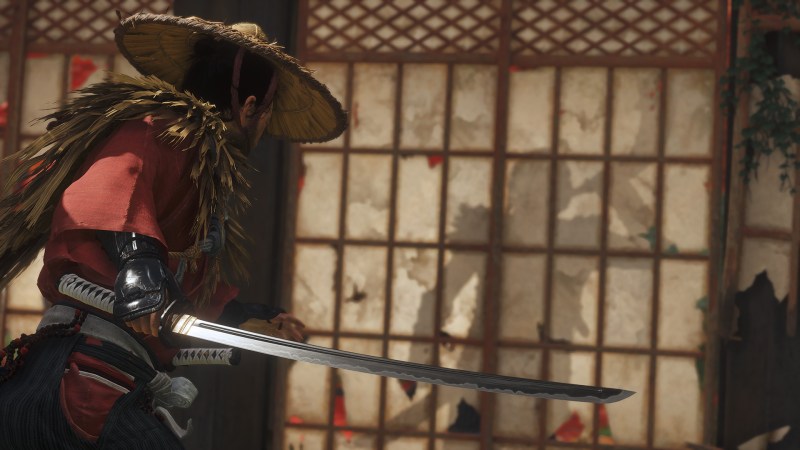
Above: Jin tries to stop an alarm by stabbing a guard through a paper door.
Question: You talked about being authentic to a time and place, but you also showed the concept of how Jin’s samurai training is not enough and so on. Does that kind of conflict there?
Zimmerman: I hope it does, right? That conflict is actually the heart of the story we’re telling. Jin’s story is about someone who has to sacrifice everything that he’s always wanted to be in order to become something that he has to be. It’s about him living by this code he’s been taught, hundreds of years of important knowledge passed down from father to son. That’s his world. He defines himself by what he’s learned. Then he’s forced into a position where that’s not enough.
So yeah, there’s absolutely conflict. We want you to feel that, to look at what he does in the demo and think, “I see some samurai there, but that part doesn’t look like samurai at all.” This is capturing a point in evolution from being pure samurai to something more than that.
Question: But is there any worry that people will read this as just taking liberties?
Zimmerman: It’ll be interesting to see. Some part of me says I hope the answer is yes, because that is the story they’re telling. If they feel conflict, they’ll maybe be able to feel Jin’s conflict, because he is conflicted in exactly that way. In terms of whether we’re treating it respectfully or not, we really do count on the team of people that we’ve assembled around us to make sure that our own instincts are on the mark. Our Japanese producers, if we do something that doesn’t feel right, they will tell us, and they do tell us.
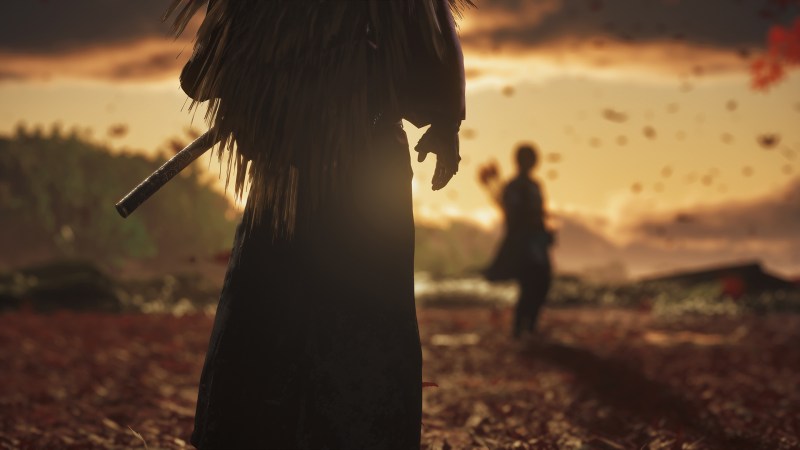
Above: Time for a duel in Ghost of Tsushima.
Question: Can you give an example of that?
Zimmerman: The one that’s fresh in my mind—the move he does, the first time you see him take the katana out of the scabbard, that’s called iaijutsu. It’s this whole fighting style around attacking from a sheathed weapon. It has a crazy lineage. There are still people studying it down 20 generations. It’s important that—this is a real thing. We were careful about exactly how that would work. Practically speaking, if you were doing that, how would you do that? If you look at it, it’s one motion, and it’s ending up. Mechanically, that’s what works. We did it differently in earlier prototypes, and the experts said, “No, that’s not right. You gotta fix that.”
Even though our instincts have usually been pretty close, getting the details right is super important. They’re not going to matter extraordinarily. Most people just say, “Whatever.” Would I have even noticed, as a guy who’s a big consumer of samurai stuff? Maybe? But it’s going to hit for somebody. Making sure that we get the details right, and the people that know—they’re going to notice things like, “Oh, that’s not modern kanji, that’s 13th-century kanji.” They’ll appreciate the fact that we have a dialogue coach on stage so that the Japanese actors are using correct phrasing for 13th-century Japanese.
Even though getting those details right may go right past most people, there will be people that recognize we’re doing it for them. That’s what it is. We’re doing it for them. If you care enough to know about this stuff, it’s going to be right.
Question: Having seen a lot of samurai movies–
Zimmerman: What’s your favorite?
Question: Probably Seven Samurai, or Ran.
Zimmerman: 13 Assassins is mine.
Question: There’s a wide variety in the way they fight in these movies. Is this a master duelist kind of fighting that we see here, or more like a battle, a melee kind of fighting?
Zimmerman: It’s interesting. The fighting system spans that whole gamut. In the demo, you saw a one-on-one fight, an iconic duel. You saw him fight a few guys. There will be times when you’ll be fighting an even larger group. Your abilities don’t change across those things. It’s the same set of moves, the same combat system that you’ve learned and invented across that whole range of situations. It has to work everywhere. The thing that changes is the enemies and the degree of challenge they represent. Masuko, if I go in and fight that fight for real, it’s not something where I go in and, bing bang boom, she’s dead. That’s actually a challenge.
It isn’t about fighting in a large battle or fighting in a duel. It’s both, all of the above. We need to make sure that when we’re working on this with our ancient fighting experts, we come up with a style that has some basis in reality, but works against these different settings and works given what you need out of a game.
When we showed you this stuff, did it feel believable? Yeah? That’s what we’re aiming for. This isn’t a game about magic spells. It’s about this grounded reality, a real person in a real place and time and how he deals with it? There really isn’t anything in the game where you’ll think, “A person couldn’t do that.” It’s not even to the level of wuxia wire-work stuff. It’s much more grounded than that. For me 13 Assassins is a great touchstone, the recent version. There’s some stuff that’s a little bit fanciful, but fundamentally it’s dudes with swords. It’s not magic powers. No 20-foot judo demons.

Above: The island of Tsushima is under attack from the Mongols.
Question: You said in the demo that it’s not just about Jin, but about the story of the island. Do your decisions affect how other things happen, whether you’ll ally with different people, things like that?
Zimmerman: We’re still working on that. Having come from 10 years of working on a game that was just about choice, we know what that means. We have not committed to a direction. I think we have to decide what’s the best way to tell the story we’re telling and how player agency is reflected. There are lots of ways to have player agency over things, as anyone who’s spent $80 on a 3D-printed statue of their World of Warcraft avatar will say. That’s agency, a very specific example. I have not done that, by the way.
But there are lots of different ways to have agency. Agency over the plot is one of those ways. We know what that feels like. We need to decide whether that’s the kind of agency we want to have in the game. I wouldn’t say we’re leaning one way or the other at this point.
Question: When you say you’re trying to make it universal, what do you think might be the differences between a Japanese fan and an American fan reacting to this game?
Zimmerman: I’m not Japanese, obviously. You probably picked that up. I think that some of it is more emotional for a Japanese player. They see something that’s—I grew up in Indiana, in the middle of a cornfield. If I see a picture of a cornfield—unless you grew up in the middle of a cornfield, it doesn’t hit you in the same way that it hits me. I think that’s one of the differences. When we work hard on something like this, or the temple, and we get it right, it hits people differently if you’re Japanese. This is your culture. This is home.
Again, that’s why it’s so important for us to get it right. That’s responsibility. You’re taking something that’s a person’s sense of who they are. You can’t screw that up. The game we’re making, we’re super excited about it, and we hope other people are excited about it, but no game is all things to all people. We think it’s going to have a lot of appeal, but if someone really wants a 20-foot-tall oni, that’s not what we’re doing. We’re not the only game in the world, and that’s fine.
Question: When you say it’s an open world experience, how do you avoid the problem of a lot of empty space, being able to get lost and not know what to do next?
Zimmerman: That’s one of the reasons why it’s been a long time. We’re used to building open world games, but the scale of this is so much bigger. We thought we knew what we were doing. This is the story of Sucker Punch. If we ever wrote the corporate history of the studio, the title would be, “We thought we knew what we were doing.” But it’s been a growth process for us.
Inside baseball: it turns out that you need to hit the right density of stuff in the environment. If you’re in a game where it’s just big for bigness’ sake, that’s not good. You get bored. We’ve played games like that, where they’re big, but kind of empty. We’re much more focused on quality of experience. That’s a challenge for us, making sure that we have the scale that people realistically expect from an open world game, but at the quality of experience that we expect of ourselves, and that anybody in the know expects of a Sucker Punch game.
It’s important that you always feel like you see some interesting things. You kind of saw that here. When you’re going through, you crest that hill and it’s gorgeous, but you also see a temple. You see a fire in the distance. You see some ships. You can always see something interesting.
As a result, when we have people play the game, they’re not just going to the next waypoint on the map. In a good open world game, you have super high distractability. No matter what you thought you were going to do, you end up spending three times as much time on it, because you get intrigued about this thing you saw. There are lots of ways for us to introduce those things into the game. We have a bazillion of them. We’re just not showing them yet.
